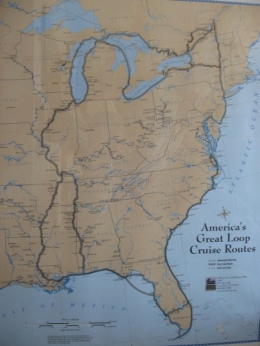
Georgetown, named after Prince George who later became George II, was founded in 1730 and is the third oldest city in South Carolina. One of the heroes of the area is Francis Marion, also known as the “Swamp Fox”, who used guerrilla warfare and eluded the British during the Revolutionary War by traveling along swamp paths. The character Benjamin Martin in the movie “The Patriot” is loosely based on Marion’s life. Indigo (dyestuff) and rice were major crops and the seaport exported more rice than any port in the world at one time.
 HAPPY MEMORIAL DAY! This is us from the town dock, I loved that it was close enough to row Ginger to shore (also public restrooms for humans were nearby). There was a "Don't Feed the Alligators" sign at the dock. We didn't see any but evidently they're plentiful in the rivers and marshes in the area.
HAPPY MEMORIAL DAY! This is us from the town dock, I loved that it was close enough to row Ginger to shore (also public restrooms for humans were nearby). There was a "Don't Feed the Alligators" sign at the dock. We didn't see any but evidently they're plentiful in the rivers and marshes in the area.We did our own walking tour of the historic district where more than 50 buildings and sites are listed on the National Register of Historic Places.
 The town did a great job with this 1500 foot Harborwalk. A number of restaurants on Front Street have access to it with outdoor seating.
The town did a great job with this 1500 foot Harborwalk. A number of restaurants on Front Street have access to it with outdoor seating. The William Doyle Morgan House (c. 1880). This one was beautifully restored.
The William Doyle Morgan House (c. 1880). This one was beautifully restored.
This historic home is now a Bed and Breakfast. I thought the porch looked really inviting.
 Here's one of the lovely streets lined with Live Oaks. There was a special sign for a 570-year old Champion Live Oak. They're called that because they're green year-round.
Here's one of the lovely streets lined with Live Oaks. There was a special sign for a 570-year old Champion Live Oak. They're called that because they're green year-round. This is Prince George, Winyah, Episcopal Church (c. 1747)
This is Prince George, Winyah, Episcopal Church (c. 1747)
Prince George is one of the few original church buildings still in use in South Carolina dating to the colonial period. The box pews were customary in colonial times. The pews were assigned a number and members owned their pew!

Since there was no heat in the church, pew owners frequently brought charcoal burners from their carriages in cold weather and the pews retained the heat. The "good old days"?

Another inviting porch on a lovely old southern home.

The sign below explains the historic building above.

 A "watch cat" sleeping on the job inside a store on Front Street.
A "watch cat" sleeping on the job inside a store on Front Street. This town landmark also houses the Rice Museum (c. 1842). It was originally an open-air market. Surrender papers were signed here in 1865.
This town landmark also houses the Rice Museum (c. 1842). It was originally an open-air market. Surrender papers were signed here in 1865.That's all for Georgetown, we really enjoyed our two nights anchored here. The only downside was the "pungent" odor from the paper/pulp mill when the wind was right. It was very similar to the air when you're nearing Kaukauna on Hwy. 41 in Northeast Wisconsin (many of you will relate!)


No comments:
Post a Comment